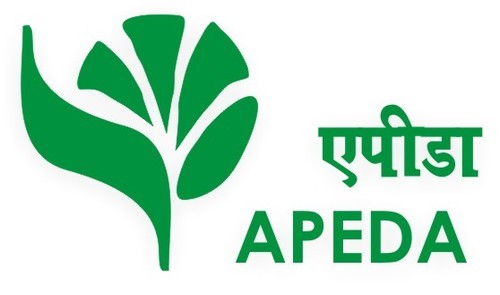
Disclaimer: Copyright infringement not intended.
Context
- Recently, Agricultural & Processed Food Products Export Development Authority (APEDA) launched a variety of millet products for all age groups at affordable prices ranging from Rs 5 to Rs 15 at the AAHAR food fair.
Ahaar Fair
- Ahaar Food Price is Asia’s biggest B2B international food and hospitality fair.
- AAHAR is a part of the series of export promotion initiatives taken by APEDA, which works under the Ministry of Commerce and Industry, to showcase agricultural and processed food products to the global players in the food and beverages industry as the fair is visited by a large number of importers from different parts of the world.
- The 36th edition of AAHAR was jointly organized by APEDA and the India Trade Promotion Organization (ITPO) at Pragati Maidan.
- To promote agricultural products APEDA put on display 33 GI agricultural products at AAHAR.
- Theme - ‘To promote GI products for export’. The APEDA also released two booklets which include a catalogue on Agri and Food GI products (APEDA scheduled) and a brochure on Indian GI mangoes. Notably, more than 150 food and agri Products have been registered as GI by the GI Registry till March 2022, out of which 123 GI products fall under APEDA’s category.
Details
Products launched
- The launched products are cream biscuits, salt biscuits, milk biscuits, ragi peanut butter, jowar peanut butter, jowar upma, pongal, khichadi and millet malts (jowar, ragi, bajra).
“Millet in Minutes” products
- APEDA also launched a variety of “Millet in Minutes” products under the category of Ready-to-Eat (RTE) such as Upma, Pongal, Khichadi, Noodles, Biryani, etc, This is a breakthrough in the food sector as it’s the first RTE millet product in the market to cater fast-paced world at their convenience in a healthy way.
Gluten free and Preservative free products
- All the millet products launched by APEDA are gluten-free, 100% natural and patented.
- All the RTE products are vacuum processed without any additives, fillers and preservatives.
- Nutrition value is retained as original with a shelf-life of 12 months in ambient temperature.
About Millets
- Millets are cereal crops with high nutritive value and categorized as small-seeded grasses.
- The key varieties of millets include Sorghum, Pearl Millet, Ragi, Small Millet, Foxtail Millet, Barnyard Millet, Kodo Millet and others.
- Major producers include Rajasthan, Andhra Pradesh, Telangana, Karnataka, Tamil Nadu, Maharashtra, Gujarat and Haryana.
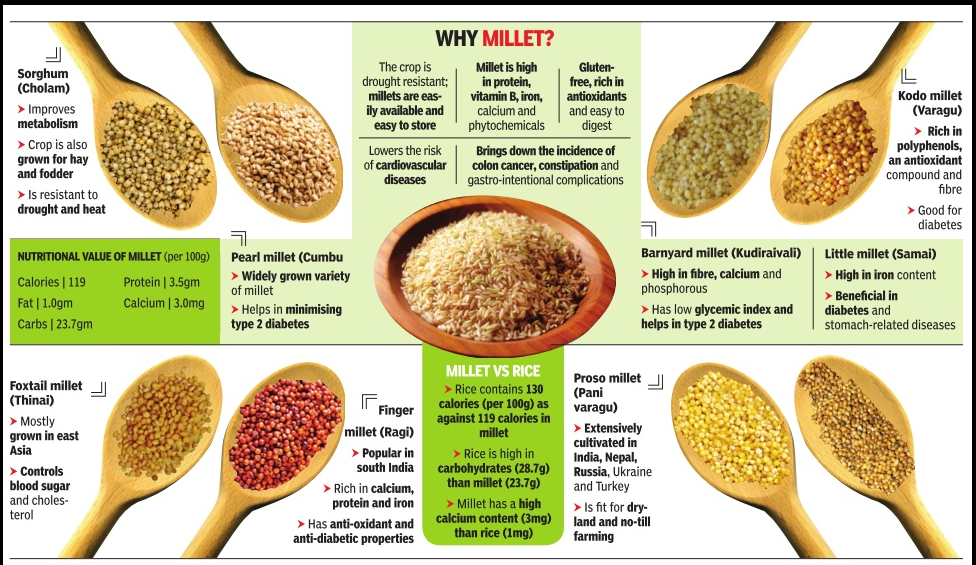
- High in dietary fibre, nutri-cereals are a powerhouse of nutrients including iron, folate, calcium, zinc, magnesium, phosphorous, copper, vitamins and antioxidants.
Importance of millets for Environment
- Millets are known for their climate-resilient features including adaptation to a wide range of ecological conditions, less irrigational requirements, better growth and productivity in low nutrient input conditions, less reliance on synthetic fertilizers, and minimum vulnerability to environmental stresses
- Millets can counter many of the adverse effects of climate change better than most other food crops. They grow in almost any type of soil – sandy or with varying levels of acidity. They hardly need any fertilisers or irrigation.
- The inter-cropping of millets with other crops is especially beneficial because the fibrous roots of millet plants help in improving soil quality, keep water run-off in check and aid soil conservation in erosion-prone areas, thereby restoring natural ecosystems.
- Thus, millets can help to phase out climatic uncertainties, reducing atmospheric carbon dioxide, and can contribute in mitigating the climate change.
Agrarian Importance of Millets for Farmers
- Dry lands constitute 40% of the global land surface and are home for about 1/3rd of the global population.
- These low fertile soils are predicted to elevate up to 50–56% in 2100 AD, and 78% of dry land expansion is expected to occur in developing countries.
- Increasingly erratic rainfall patterns and crop losses due to climate change factors has affected farmers tremendously.
- The spate of farmer’s suicides in an agriculture-based country like India has reached to an average of 52 deaths/day, and reports of farmers selling their blood to earn a livelihood in drought-hit region of the country depict the severity of the agrarian crisis.
- There is a lesser possibility of increasing the production of major staple cereals as the world is already facing the challenges of increase in dry lands and deepening of ground water level .
- According to the report of the National Rainfed Area Authority (NRAA) even after realizing the full irrigation potential, about half of the net sown area will continue to remain rainfed .This alarms the need of shifting to the alternative of current cereal staples.
- The need of the hour is to adapt to climate change by switching from water-intensive rice, sugarcane and maize cultivation to various types of drought-resistant millets
- Millets cultivation can be a solution to this problem as these can grow on shallow, low fertile soils with a pH of soil ranging from acidic 4.5 to basic soils with pH of 8.0. Millets can be a good alternative to wheat especially on acidic soils.
- Unlike rice and wheat that require many inputs in terms of fertiliser and water, millets grow well in dry regions as rain-fed crops.
- Therefore, boosting millet cultivation will empower the average farmer and achieve the objectives of enhancing incomes and improving crop diversification.
Measures being taken to promote Millet
- The APEDA is also working in collaboration with the Department of Agriculture and Farmers Welfare to increase cultivation area, production and productivity of millets, including bajra, jowar and ragi.
- In view of the nutritional value of the millets, the government has notified millets as nutri-cereals in April, 2018. The millets are a rich source of protein, fibre, minerals, iron, calcium and have a low glycemic index.
- In March, 2021, the United Nations General Assembly (UNGA) has declared 2023 as International Year of Millets.
- Because of initiatives of the government, production of millets increased from 14.52 million tonnes in 2015-16 to 17.96 million tonnes in 2020-21 and the production of Bajra has also increased from 8.07 million tonnes to 10.86 million tonnes during the same period.
A multi-pronged strategy of the Government
- First strategy from a consumption and trade point of view was to re-brand coarse cereals/millets as nutri-cereals. Till 2018-19, millet production was extended to over 14 states.
- Second, the government hiked the MSP of nutri-cereals, which came as a big price incentive for farmers. As we compare the data on MSPs for food crops from 2014-15 against 2020, we see that the MSP for ragi has jumped a whopping 113 per cent, followed by bajra and jowar at 72 per cent and 71 per cent respectively. MSPs have been calculated so that the farmer is ensured at least a 50 per cent return on their cost of production.
- Third, to provide a steady market for the produce, the government included millets in the public distribution system.
- Fourth, the Ministry of Agriculture & Farmers’ Welfare is running a Rs 600-crore scheme to increase the area, production and yield of nutri-cereals.
- With a goal to match the cultivation of nutri-cereals with local topography and natural resources, the government is encouraging farmers to align their local cropping patterns to India’s diverse 127 agro-climatic zones.
- Provision of seed kits and inputs to farmers, building value chains through Farmer Producer Organisations and supporting the marketability of nutri-cereals are some of the key interventions that have been put in place.
- And finally, the Ministry of Women and Child Development has been working at the intersection of agriculture and nutrition by setting up nutri-gardens, promoting research on the inter-linkages between crop diversity and dietary diversity and running a behaviour change campaign to generate consumer demand for nutri-cereals.
APEDA
- Agriculture and processed food production export Development Authority (APEDA) is an apex body that promotes export trade of agricultural products in India.
- Set-up by the Ministry of Commerce and Industry, APEDA was formed under the act passed by parliament in 1985.
- APEDA is mandated with the responsibility of export promotion and development of the following scheduled products:
- Fruits, vegetables and their products
- Meat and meat products
- Poultry and poultry products
- Dairy products
- Confectionery biscuits and Bakery products
- Honey, jaggery and sugar products
- Cocoa and its products, Chocolates of all kinds.
- Alcoholic and non-alcoholic beverages
- Cereal and cereal products
- Groundnuts peanuts and walnuts
- Pickles, papads and chutney
- Guar gum
- Floriculture and its products
- Herbal and Medicinal plants
- The above product categories are almost covered 50% of all Agriculture products exported from India.
- APEDA has also been entrusted with the responsibility to monitor import of sugar.
|
The Department of Commerce also has several schemes to promote agricultural products, viz. Trade Infrastructure for Export Scheme (TIES), Market Access Initiatives (MAI) Scheme, Merchandise Exports from India Scheme (MEIS) etc.
|
India’s Agriculture Export Policy
- The Agricultural Export Policy was introduced in 2018 to increase and provide support to productivity, pre and post-harvest management, value-addition and upgrade technology.
Objectives
- To Double Agricultural Exports
- To diversify our Export Basket, destinations and boost high value and value added agricultural exports including focus on perishables.
- To promote novel, indigenous, organic, ethnic, traditional and non-traditional Agri products exports.
- To provide an institutional mechanism for pursuing market access, tackling barriers and deal with sanitary and phyto-sanitary issues.
- To strive to double India’s share in world agri exports by integrating with global value chain at the earliest.
- Enable farmers to get benefit of export opportunities in overseas market.
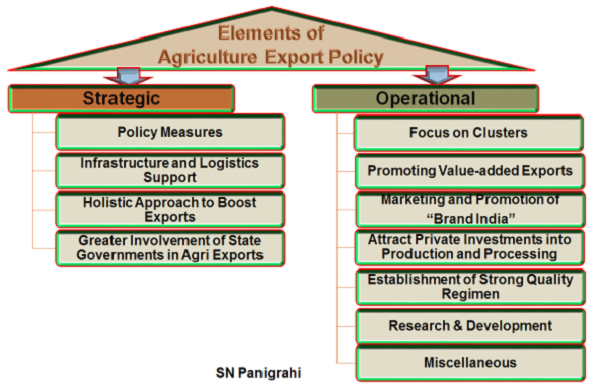
Recommendations of India’s Agriculture Export Policy
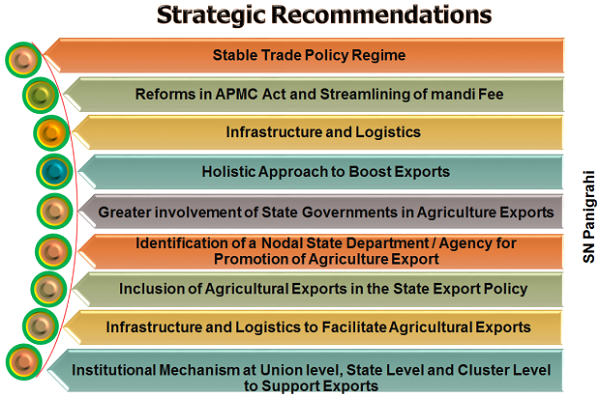
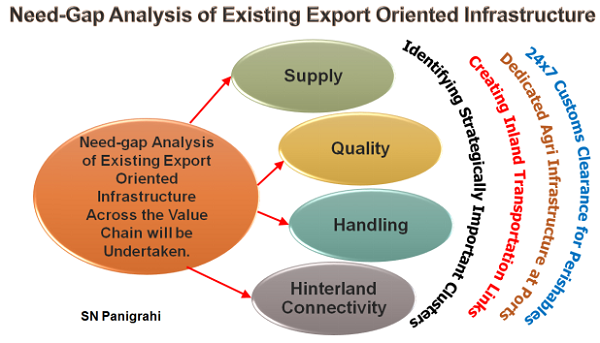
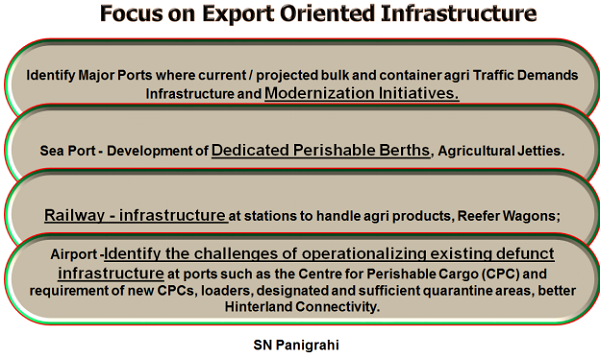
Initiatives taken by APEDA to boost Agri exports
- Paperless office, enabling digital signatures and electronic payment facilities.
- Phase-wise delivery of online services.
- Monitoring and evaluation, uniform access to shippers and conducting virtual trade fairs.
- Cent per cent digitization of issuing registration-cum-allocation certificate (RCAC), by enabling online payment gateway and digital signatures.
- Integration of peanut processing units and laboratories into a single window system for certification of peanut (groundnut) exports. This includes issuing online certificates of exports. The authority has also launched similar initiatives with regard to meat exports.
- Hortinet: An integrated traceability system covering 40-plus vegetable. It provides Internet based electronic services to the stakeholders for facilitating farm registration, testing and certification of Grape, Pomegranate and Vegetables for export from India to the European Union in compliance with standards.
- A traceability System for Basmati rice (a registered GI product).
- Grapenet - a web based certification and traceability software system for monitoring fresh grapes exported from India to the European Union.
- APEDA compiles and disseminates various international trade analytical information, market access information amongst exporters and address trade enquiries.
- APEDA assists in up-gradation and strengthening of recognized laboratories for export testing and residue monitoring plans.
- Assistance under the financial assistance schemes of infrastructure development, quality improvement and market development for boosting export of agricultural products.
- FarmerConnect portal to help farmer producers' organisations, cooperatives and exporters. This helps them to create profiles and post their sale offers on the web platform. Exporters can also post their enquiries or needs, and view matching sale offers.
- Virtual Trade Fair -A meeting place for exhibitors, visitors, exporters and industry to exchange information on new products and establish new partnerships.
- SaaS model: Hybrid solution combining its traditional web-based SaaS model for its stakeholders, augmented by an authentic, private Blockchain layer for further data security and authentication.
- In line with PM Modi’s clarion call for “vocal for local” and ‘Atmanirbhar Bharat’, the authority has been focussing on the promotion of exports of locally-sourced Geographical Indication (GI) products besides indigenous, ethnic agricultural products unique from north-eastern and hilly states.
- A Market Intelligence Cell has been set up in APEDA and it has begun putting out E-market intelligence reports comprising detailed market analysis.
These initiatives have, helped Indian agricultural exports fare well during COVID pandemic when shipments were affected due to various factors, including lockdowns.
According to WTO’s trade map, with the total agri-exports of USD 37 billion in the year 2019, India is ranked at 9th position in the world ranking.
Trivia

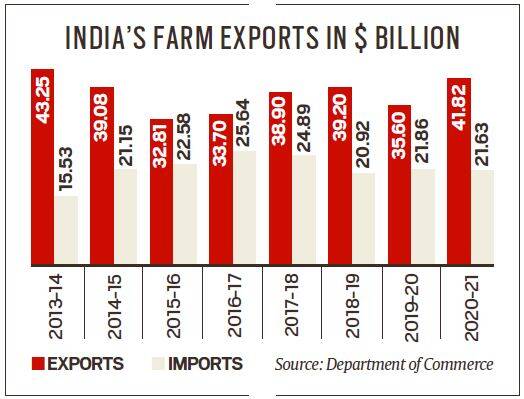
- Cereals represent the fastest grower among the top 10 export categories, up by 22.7% from 2019 to 2020.
- India's agriculture exports cross $50 bn in FY22, the highest ever. The agricultural exports have grown by 19.92% in FY22 to touch $ 50.21 billion. The growth rate is remarkable as it is over and above the growth of 17.66%, at $41.87 billion, achieved in 2020-21.
- India is seeing growth in the export of cereals, non-basmati rice, wheat, millets, maize, and other coarse grains.
- Organic exports that include products such as cereals and millets, spices and condiments, tea, medicinal plant products, dry fruits, and sugar grew 51 per cent year on year to $1,040 million.
Final Thought
- The significant spike in agri-exports is a testimony of the government’s commitment to increase farmers’ income.
- This is being done through giving thrust on boosting exports of agricultural and processed food products of the country.
https://www.pib.gov.in/PressReleasePage.aspx?PRID=1821647











